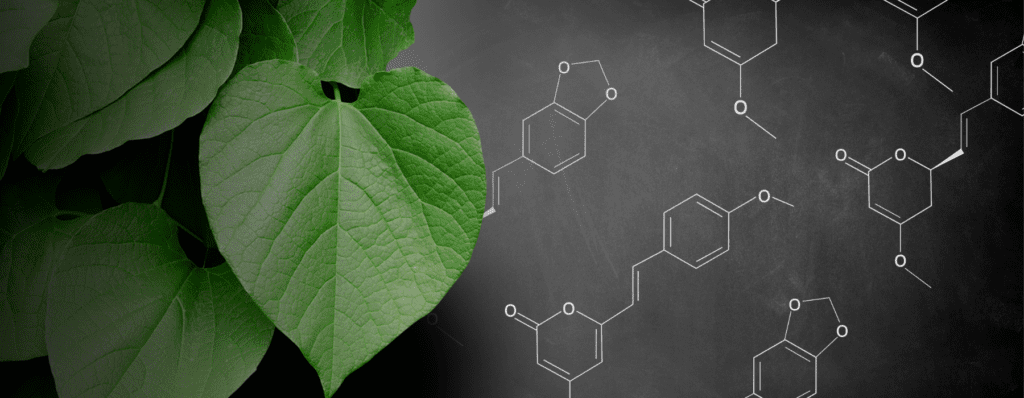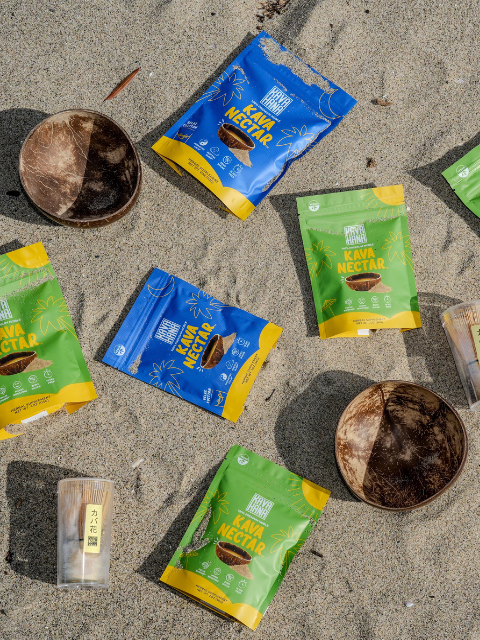In our fast-paced, stressful world, finding natural remedies to soothe the mind and body is more important than ever. While many of us turn to alcohol to help us relax and unwind, it comes with negative side effects like hangovers that leave you feeling mentally groggy and physically ill. Kava, with it’s potent kavalactones, is emerging as an option for relaxing and destressing with out the side-effects.
Kava is gaining popularity as an alcohol alternative because it is not only alcohol-free but also an herbal drink with noticeable effects. Known for promoting feelings of clarity, calm, and relaxation, kava can help reduce anxiety and improve sleep. The secret lies in the kavalactones, potent compounds that interact with the brain to alter its chemistry, producing the soothing effects kava is renowned for.
A story of kavalactones
Kavalactones create a special form of polyketides. These are naturally occurring organic compounds that are produced by fungi, bacteria and plants. They can come in many different shapes and sizes and can act as antibiotics, antifungals, anti-cancer, and even suppress the immune system.
Eighteen kavalactones are known to exist however only six are known to be responsible for 96% of the effects of kava. These are
- Methysticin (M)
- Dihydromethysticin (DHM)
- Yangonin (Y)
- Desmethoxyyangonin (DMY)
- Kavain (K)
- Dihydrokavain (DKM).
The different cultivars of kava each contain a certain number and amount of kavalactones. This balance is what gives each type of kava its specific effects. These can be generally divided into three groups: heady, heavy, or balanced.
Heady kavas act on the mind. They usually have a higher concentration of lighter kavalactones, giving you the feeling of mental clarity, calm, and sociability. Because of their slightly more activating effects, it’s best to drink these varieties during the day when you’re looking for a little boost or getting ready to socialize with friends and family.
On the other hand, heavy kavas target the body. They’re made up of the stronger kavalactones, affecting your muscles and leaving your body and limbs feeling heavy, tired, and relaxed. These kavas promote deeper relaxation and last longer than heady kavas, so they are best drunk in the evening or night when you’re looking for a relaxing night in or getting ready for sleep rather than socializing.
As you may have guessed, balanced kavas are in between heavy and heady kavas. These can be used either during the day or at night, depending on how much you take. Balanced kavas are a great way to understand how kava affects your body and mind when first trying it out. They are also for more experienced users who want to experience the full spectrum of what kava offers.
We can go even further and look at each plant’s chemocode. The chemocode is the specific combination of kavalactones that make up the different types of kava.
What makes up the chemotcode
The chemocode refers to the kavalactone make-up of the kava plant. It involves measuring the levels of kavalactones in each plant and ordering them from highest to lowest. For example, if a plant has the chemo code 346125, we know that Yangonin (3) is the highest strain, then Kavain (4), Methysticin (6), and so on. This creates a unique chemocode for each plant.
Once the chemocode is determined, the type of kava can be put together into a chemocode group. These groups contain kavas that share similar effects and are categorized as A through I.
Knowing chemocode groups and kava cultivars helps you better understand what kava to use for the experience you want. For example, chemocode groups A-D have extreme side effects and are NOT recommended for recreational drinking. Similarly, groups E and F have high levels of DHK, and DHM has negative effects like nausea, and headache and lasts a much longer time (up to two days!). The best groups for regular drinking are G-I since they have the kavalactones that give us the mental and physical effects we expect when using kava.
Why is this important
At first, this information might seem overwhelming. However, as you become more familiar with kava and drink it more often, you’ll realize how helpful knowing and understanding kavalactones can be.
Each type of kavalactone affects your body and mind differently, much like how different types of alcohol (such as tequila versus wine) have distinct effects. It is crucial to identify the specific strain of kava that matches your desired effects, as it significantly shapes your response and overall experience with kava. For instance, taking a heavy kava when you’re going out to spend a night with friends will leave you feeling tired and sluggish rather than relaxed and sociable.
Understanding kavalactones is essential for fully appreciating the kava’s unique benefits. By understanding how different kavalactones affect your body and mind, you can select the right kava strain to suit your needs, whether it’s for relaxation, stress relief, or a good night’s sleep. This knowledge enhances your kava experience, allowing you to harness its full potential for a balanced and optimal life.


